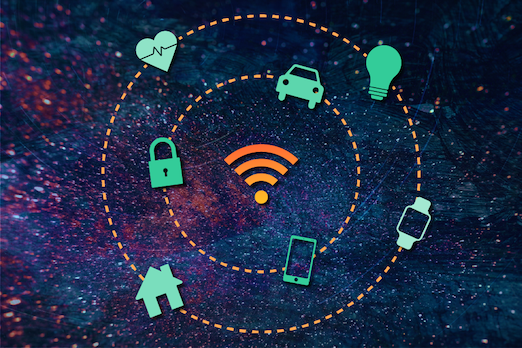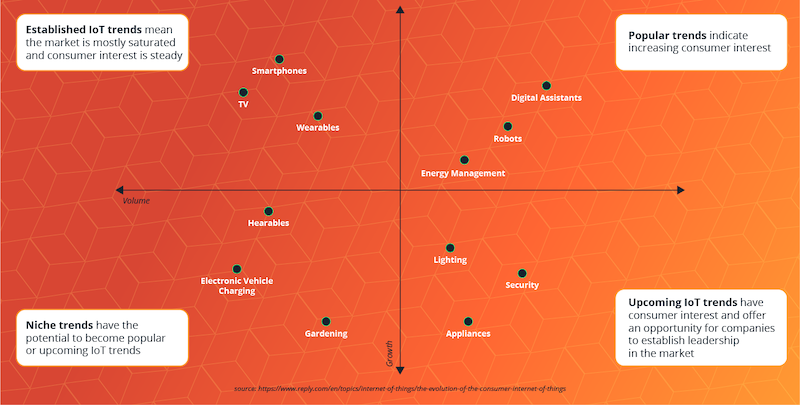What Connected Devices Mean for Business and Content Management

While 2030 may seem a long way off, in the age of fast-paced business transformation smart organizations are already looking at least that far out when it comes to planning. One of the most impactful trends we’re anticipating in the coming decade is the overwhelming adoption by businesses and consumers of internet-connected devices that will automate and personalize almost every aspect of modern life and work.
However, if we learned anything from Spider-Man’s wise Uncle Ben, it’s that with great power comes with great responsibility. In other words, the opportunities posed by adopting connected devices and the internet of things (IoT) do not come without some inherent risks.
Knowing such, let’s explore what IoT is and what it means for businesses today, what precipitated its popularity, what devices we can expect to come online in the near future, and which key opportunities and risks every company needs to be aware of when planning for the future.
What Is the Internet of Things?
The internet of things is an interlacing web of “smart,” physical devices that can be powered on, connected to the internet, and, quite often, connected to one another.
For consumers, these devices can include anything from light bulbs to coffee makers, headphones, TVs, security systems, wearables, self-driving cars, and plenty more. Consumers can often link many of these devices together to collect data and perform automated actions in what’s come to be known as a “connected home.”
The IoT also exists outside the consumer world. Healthcare, manufacturing, financial services, transportation, telecommunication, and other industries connect smart parts and devices to the internet and each other to power analytics, artificial intelligence, and automation.
In 2017, 27 billion devices were connected using IoT. This number is expected to increase to 125 billion by just 2030, which will put about 15 connected devices into the hands of every consumer. The $170 billion IoT market is expected to grow to $561 billion by 2022.
We’ll see a proliferation of connected devices in our future. Now the questions are: Which ones and why now?
Which Devices and Why Now?
The explosion of IoT devices can be chalked up to a perfect storm of technological and societal changes.
Today, one can get quality processors, sensors, and other hardware elements that power connected devices at an affordable price. In addition, AI is developing smarter insights and automations by the day, broader and more powerful networks put connectivity at an all-time high, and the decreasing cost of storage means collecting and analyzing big data is no longer a hindrance.
It also helps that our society has largely adopted digital technology as part of everyday life. We’re more mobile than ever and have come to expect the convenience and time savings that automated, personalized technology provides. Right now, 53 percent of the global population is connected to the internet—and that number is sure to grow as connected devices get more affordable.
Smartphones, TVs, and wearables are some of the more established IoT devices that have moved from the niche sector to become widely discussed and adopted. Popular trends like digital assistants, in-home robots, and smart energy management offer opportunities for companies who want to break into consumer IoT devices. In-home electric car chargers, “wireless in-ear computational earpieces” orhearables, and even smart gardening devices make up the niche space while apparent up-and-coming trends include smart lighting, smart appliances, and more.
IoT Means New Business Opportunities
While it’s hard to imagine every business opportunity the new age of connectivity will present, right now we don’t think proactive customer service, more powerful content, and data-enriched products, marketing campaigns, and internal processes are a bad place to start.
Bigger Data Improves Product Development, Marketing, and Internal Workflows
Data has become a currency. Consumers and organizations alike realize that if they’re willing to grant access to their data, the payoff will be smarter, more personalized devices. This presents an excellent opportunity for businesses who know how to cash in on big data. One one side, third-party services that can effectively store, protect, manage, analyze, and use data will boom. At the same time, companies can use their data to understand their audience better and develop and market products that serve them well. Internally, data will empower businesses to understand and automate their own systems to optimize efficiency and output.
Content Will Play an Even Larger Role in Business Success
IoT presents more opportunities for content to be surfaced—and in entirely different ways—than ever before. AI-powered and voice-activated devices will become foundational search tools. While this opportunity certainly means your content could become more useful in more situations, it also means marketers will have to overhaul the way they target searches. At the same time, IT will have to structure content in such a way that it can be served seamlessly from a smart watch’s screen to a washing machine’s digital display to a voice-activated device’s response.
A headless content management system (CMS) empowers businesses to take advantage of this opportunity by allowing them to create content just once and publish it everywhere. Because a headless CMS has no built-in front-end system that determines how or where content will be displayed, content managers can quickly optimize and serve consistent experiences on websites, apps, chatbots, connected home devices, voice assistants, and more.
If you’re looking for a headless CMS that also lets you seamlessly integrate a powerful personalization engine of your choice to segment and optimize content, AI-enabled widgets that analyze and improve performance, and enterprise-ready security and business features—we invite you to take a look at Contentstack.
Proactive Customer Support, Simplified
As the number of connected devices and people steadily ticks up, so does the need for support. The opportunity to provide customer support can backfire for businesses that don’t have the resources to scale. That is, unless they’re able to turn the IoT inward and establish AI-enabled customer support that knows what a customer needs before they even know it themselves.
A handy side-effect of connectivity is that companies finally have insight into how their products are performing long after they’ve been integrated into users’ homes and businesses. Now, the company instead of the consumer can initiate a customer service interaction based on what they’re able to see pertaining to device performance, usage patterns, and more. Customer service will go proactive instead of reactive.
A great example of proactive customer service in action is Michelin’s truck tires, which contain IoT-enabled sensors that monitor air pressure and wear and tear. With these sensors, Michelin can alert transportation companies to any issues well before a dangerous malfunction occurs.
The Risks IoT Presents for Businesses Today
Just like any significant shift in the business or technology ecosystem, the trend toward IoT-enabled devices comes with its downfalls. However, with careful planning and thoughtful technology adoption, we believe the major risks that outmoded security and content management present can be effectively mitigated.
Your Current Website Isn’t Going to Cut It
According to GlobalWebIndex, the average digital consumer owns three different internet-enabled devices (for now). And Nielsen found that, in 2018, American adults spent nearly four hours per day consuming media on them.
Today, people are switching between gadgets and displays whether they’re working, consuming entertainment, or making a purchase. The businesses that will win their attention are those that can serve the right content, on the right device, at the right time during the digital experience.
Unfortunately, if you’re using a traditional CMS, you won’t be prepared to do that.
With a traditional CMS (think Drupal, WordPress, etc.), content is saved to a built-in database and displayed to the built-in front-end delivery system. Because the content and its delivery are permanently connected, there is little opportunity to personalize the messaging for different segments or optimize the display for different devices.
However, a headless CMS with CRM, DAM, and marketing automation integrations (Contentstack’s Experience Extensions revolutionize this concept) makes it easy to gather consumer data from a single source of truth, use it to personalize content right inside the editor, and segment delivery for optimal results.
Even the mother of all search engines, Google, is reinforcing the omnichannel imperative with mobile-first indexing that checks out the mobile version of your website first when it comes time to determine search engine ranking as well as a focus on voice-search-optimized content.
Security Concerns Are More Than Justified
Even in 2019, only 48 percent of companies can detect security breaches in their IoT devices—despite increased spending and a general acknowledgment that IoT security is a business’ ethical responsibility.
In the age of IoT, data security is more critical, yet weaker, than ever. That’s because as more devices get connected to the internet, security coverage becomes thinner for each and hackers gain more opportunities from which to attack. During Q3 of 2017, organizations in the UK suffered an average of 237 attacks per month—up 35 percent from Q2 and 90 percent from Q1 of the same year.
On the bright side, Contentstack helps enterprise organizations keep their valuable content assets safe with features like network security, a virtual private cloud, data encryption, log data retention, two-factor authentication, password protection, and stringent compliance and GDPR measures.
What Will IoT Mean for the Future of Your Business?
When estimates state that the average person will own and use at least 15 connected devices by the year 2030, one thing we know for sure is that businesses must be thinking about the risks and opportunities of IoT today.
Will opportunities like proactive customer support, more powerful content, and data-enriched products, marketing campaigns, and internal workflows be enough to convince you to optimize your business to take advantage of smart, connected devices? Or, will the risks associated with a substantial content re-platforming project and possible security concerns keep you away from the IoT?
While we can’t tell you how to plan for the future of your business, we can provide one of the most important tools for future-proofing your content assets and management efforts against major disruption. We can provide Contentstack’s revolutionary headless CMS.
Contentstack offers advanced features like digital asset management, version control, approval workflows, optimization plugins, and more for content creators as well as enterprise-level availability, security, and scalability for IT teams. Go ahead, use our ROI calculator to find out how much you can save annually with Contentstack or take it for a test drive and build out a (free!) proof-of-concept today.
About Contentstack
The Contentstack team comprises highly skilled professionals specializing in product marketing, customer acquisition and retention, and digital marketing strategy. With extensive experience holding senior positions in notable technology companies across various sectors, they bring diverse backgrounds and deep industry knowledge to deliver impactful solutions.
Contentstack stands out in the composable DXP and Headless CMS markets with an impressive track record of 87 G2 user awards, 6 analyst recognitions, and 3 industry accolades, showcasing its robust market presence and user satisfaction.
Check out our case studies to see why industry-leading companies trust Contentstack.
Experience the power of Contentstack's award-winning platform by scheduling a demo, starting a free trial, or joining a small group demo today.
Follow Contentstack on Linkedin
Share on:





.jpg?format=pjpg&auto=webp)





